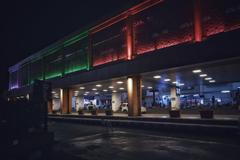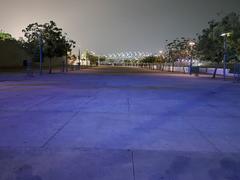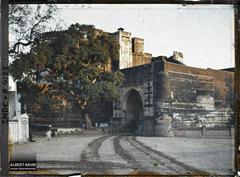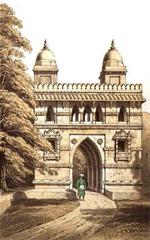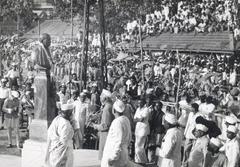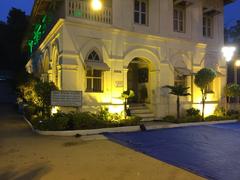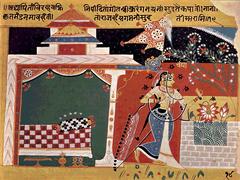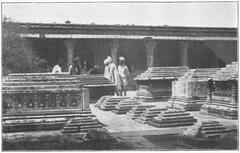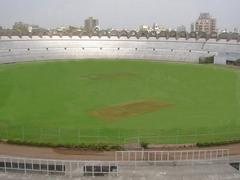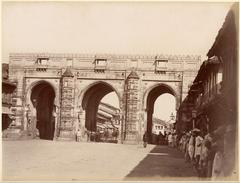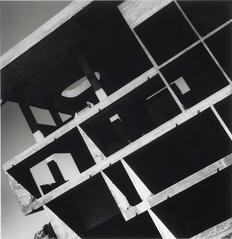Magen Abraham Synagogue Ahmedabad: Visiting Hours, Tickets, and Historical Significance
Date: 04/07/2025
Introduction
Magen Abraham Synagogue stands in the heart of Ahmedabad as Gujarat’s only synagogue and a rare testament to India’s Bene Israel Jewish heritage. Established in 1934, this heritage site reflects the city’s multicultural fabric through its unique Indo-Judaica and Art Deco architecture, as well as its continued role in the cultural and spiritual life of the Jewish community. This comprehensive guide covers the synagogue’s fascinating history, architectural highlights, visiting hours, ticket policies, accessibility, etiquette, and nearby attractions—helping you plan a rewarding visit and deeper understanding of one of Ahmedabad’s most significant historical sites.
Table of Contents
- Historical Background
- Architectural Features and Cultural Significance
- Community Life and Contemporary Role
- Visitor Information
- Guided Tours and Special Events
- Entry Requirements and Dress Code
- Best Time to Visit
- Nearby Attractions
- Practical Tips for Visitors
- Frequently Asked Questions (FAQ)
- Conclusion
- References
Historical Background
Early Jewish Settlement in Ahmedabad
The story of Magen Abraham Synagogue begins with the arrival of Bene Israel Jews in Ahmedabad in 1848, migrating from the Konkan coast and Mumbai in search of opportunities during British rule (indianjews.org). Initially, the community found employment in the British army, railways, and later in professions such as law, medicine, and textiles. They quickly integrated into the city’s social and educational life, founding English-medium schools and contributing to Ahmedabad’s cosmopolitan growth (heritage.ahmedabadcity.gov.in).
Formation of the Community and Synagogue Construction
Initially, religious gatherings took place in private homes. Dr. Abraham Erulkar established a prayer hall in his residence, and after his passing in 1890, the community consecrated a Jewish cemetery at Dudheshwar. By 1906, a dedicated prayer hall was funded in Pankor Naka. As the community grew, the need for a larger synagogue emerged. In 1933, construction began on the current synagogue in Bukhara Mohulla, near Kamasa Gate—a neighborhood renowned for its religious diversity (indianjews.org). Designed by Daniel Samson and Ellis Abraham Bhinjekar, with significant support from Dr. Solomon Erulkar, the synagogue was consecrated in 1934 and named “Magen Abraham” (“Shield of Abraham”), honoring Dr. Erulkar’s contributions (heritage.ahmedabadcity.gov.in).
Architectural Features and Cultural Significance
Magen Abraham Synagogue is a striking blend of Art Deco, European, and traditional Jewish design, setting it apart from the Mughal and Indo-Saracenic styles common in Ahmedabad (Gujarat Tourism). Key features include:
- Art Deco Facade: The exterior boasts a symmetrical facade with a triangular pediment and Grecian columns supporting a lofty roof.
- Stained Glass Windows: Colorful stained glass fills the sanctuary with natural light and Jewish motifs.
- Pillar-less Women’s Gallery: The unsupported ladies’ gallery is a unique architectural element among Indian synagogues.
- Central Bimah and Movable Pews: The sanctuary’s pews surround a central platform for Torah readings, fostering communal worship.
- Ark (Aron Kodesh): The marble-adorned Ark houses treasured Torah scrolls, with inscriptions in Hebrew and Marathi, reflecting the community’s cultural integration.
- Artistic Details: Marble chequered floors, elegant chandeliers, and intricate metal grills demonstrate the craftsmanship of the Bene Israel community (Knocksense).
The synagogue’s location, directly opposite a Parsi Fire Temple, exemplifies Ahmedabad’s history of interfaith harmony and pluralism (Wikipedia).
Community Life and Contemporary Role
At its peak in the 1930s, Ahmedabad’s Jewish population reached about 800. Today, the community numbers around 120–125 but remains active, celebrating Jewish festivals, life-cycle events, and hosting educational programs. Notable community members include Reuben David (founder of Kankaria Zoo), Dr. Esther Solomon (Sanskrit scholar), and novelist Esther David, all recipients of the Padma Shri (heritage.ahmedabadcity.gov.in). The synagogue’s resilience is marked by continued worship, community gatherings, and its role as both a spiritual home and living museum.
In 2015, the City of Ahmedabad designated the synagogue a protected heritage building; in 2018, the Gujarat government recognized Jews as a minority, underscoring their contributions to the state’s pluralistic identity (Wikipedia).
Visitor Information
Visiting Hours and Tickets
- General Hours: The synagogue is typically open from 9:00 AM to 5:00 PM, Monday through Saturday. It is closed on major Jewish holidays and Sundays (TripInvites; Experience Ahmedabad).
- Popular Visiting Times: Afternoons are most common, with 3:00 PM being especially popular.
- Entry Fee: There is no mandatory fee. Donations for maintenance are appreciated.
- Tickets: No advance tickets or reservations required, but calling ahead is advised during festival periods.
Accessibility and Facilities
- Location: Khamasa area, old Ahmedabad, easily accessible by taxi, auto-rickshaw, or public transport (Trek Zone).
- Wheelchair Access: Ramps are available, but narrow roads and heritage constraints may limit full accessibility.
- Restrooms: Basic facilities are available; nearby cafes or hotels may be preferable.
- Parking: Limited—public transport is recommended.
Photography and Visitor Conduct
- Photography: Permitted with prior permission; avoid flash and be respectful during services.
- Dress Code: Modest attire is required (shoulders and knees covered). Remove shoes before entering the main prayer hall.
- Etiquette: Maintain quiet and respectful behavior; refrain from phone use and loud conversation.
Guided Tours and Special Events
- Guided Tours: Can be arranged by advance request. Caretakers and community members often share historical and cultural insights (TripHobo).
- Festivals: Major Jewish festivals such as Passover, Hanukkah, Rosh Hashanah, and Yom Kippur are celebrated here. Visitors may attend with prior arrangement but should confirm accessibility in advance.
Entry Requirements and Dress Code
- Identification: Visitors may be asked to provide a photocopy of a valid photo ID for security.
- Dress Code: Wear modest clothing; avoid sleeveless tops, shorts, or revealing attire.
- Gender Areas: Respect the separation and signage for the ladies’ gallery, a unique feature of the synagogue (Amrita Travel Blog).
Best Time to Visit
- Ideal Months: November to February (mild temperatures and low humidity).
- Avoid: Summer (March–June) due to heat and monsoon (July–September) due to heavy rains.
- Jewish Holidays: Access may be limited; check the calendar in advance (Experience Ahmedabad).
Nearby Attractions
The synagogue’s central location allows easy exploration of other Ahmedabad heritage sites:
- Jama Masjid: 6-minute walk.
- Sidi Saiyyed Mosque: 10-minute walk.
- Rani no Hajiro: 10-minute walk.
- Ahmed Shah’s Tomb: 8-minute walk.
- Kalupur Swaminarayan Mandir: 19-minute walk.
- Bhadra Fort and Ellis Bridge: Also within walking distance (Trek Zone).
Practical Tips for Visitors
- Confirm visiting hours with the synagogue or local tourism office before your trip.
- Dress modestly and remove footwear in the prayer hall.
- Respect privacy and avoid disturbing worshippers.
- Bring a camera to capture architectural details (with permission).
- Combine your visit with other nearby attractions for a richer experience.
- Use taxis or auto-rickshaws to navigate the narrow lanes.
- Stay hydrated and carry water, especially in warmer months.
- Learn about the Bene Israel community to appreciate the synagogue’s cultural context.
Frequently Asked Questions (FAQ)
Q: What are the Magen Abraham Synagogue visiting hours?
A: Typically from 9:00 AM to 5:00 PM, Monday to Saturday. Closed on Sundays and major Jewish holidays. Confirm locally for current hours.
Q: Is there an entry fee or ticket required?
A: No entry fee or advance ticket is needed; donations are welcome.
Q: Are guided tours available?
A: Yes, by prior appointment or on-site with caretakers or community members.
Q: Can I take photographs inside?
A: Yes, but always ask permission first, especially during prayers.
Q: Is the synagogue wheelchair accessible?
A: Accessibility is limited due to heritage architecture and narrow roads, though ramps are available at the entrance.
Q: What nearby attractions can be visited along with the synagogue?
A: Jama Masjid, Sidi Saiyyed Mosque, Rani no Hajiro, Ahmed Shah’s Tomb, Kalupur Swaminarayan Mandir, and Bhadra Fort.
Conclusion
Magen Abraham Synagogue is much more than a place of worship; it is a living monument to the Bene Israel Jewish community’s enduring presence in Gujarat. Its unique blend of Art Deco and Indo-Judaica architecture, central role in community life, and location amidst other Ahmedabad historical sites make it an essential stop for travelers interested in the city’s pluralistic heritage. Take advantage of free entry, the chance to interact with community members, and the opportunity to witness unique features such as the unsupported women’s gallery and elaborately inscribed Ark. Whether you are an architecture enthusiast, history buff, or cultural explorer, a visit to Magen Abraham Synagogue will deepen your appreciation of Ahmedabad’s rich and diverse history.
For updated information on visiting hours, special events, and accessibility, refer to official resources and consider using travel apps like Audiala for enhanced experiences.
